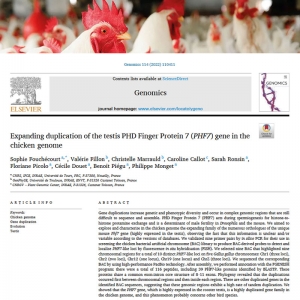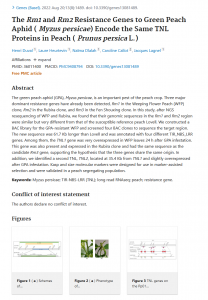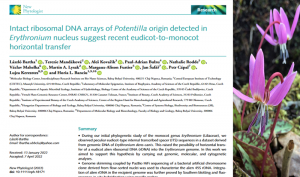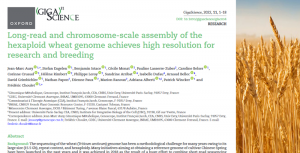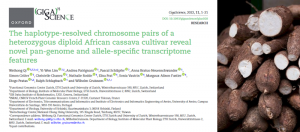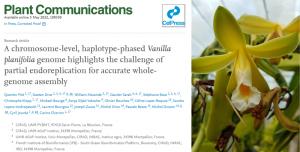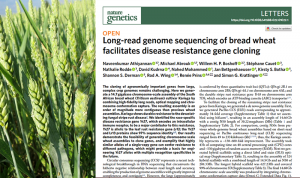2022 publications

Capturing Wheat Phenotypes at the Genome Level
Babar Hussain, Bala A. Akpınar, Michael Alaux, Ahmed M. Algharib, Deepmala Sehgal, Zulfiqar Ali, Gudbjorg I. Aradottir, Jacqueline Batley, Arnaud Bellec, Alison R. Bentley, Halise B. Cagirici, Luigi Cattivelli, Fred Choulet, James Cockram, Francesca Desiderio, Pierre Devaux, Munevver Dogramaci, Gabriel Dorado, Susanne Dreisigacker, David Edwards, Khaoula El-Hassouni, Kellye Eversole, Tzion Fahima, Melania Figueroa, Sergio Gálvez, Kulvinder S. Gill, Liubov Govta, Alvina Gul, Goetz Hensel, Pilar Hernandez, Leonardo Abdiel Crespo-Herrera, Amir Ibrahim, Benjamin Kilian, Viktor Korzun, Tamar Krugman, Yinghui Li, Shuyu Liu, Amer F. Mahmoud, Alexey Morgounov, Tugdem Muslu, Faiza Naseer, Frank Ordon, Etienne Paux, Dragan Perovic, Gadi V. P. Reddy, Jochen Christoph Reif, Matthew Reynolds, Rajib Roychowdhury, Jackie Rudd, Taner Z. Sen, Sivakumar Sukumaran, Bahar Sogutmaz Ozdemir, Vijay Kumar Tiwari, Naimat Ullah, Turgay Unver, Selami Yazar, Rudi Appels and Hikmet Budak
- Frontiers in Plant Science
Voir plus
Recent technological advances in next-generation sequencing (NGS) technologies have dramatically reduced the cost of DNA sequencing, allowing species with large and complex genomes to be sequenced. Although bread wheat (Triticum aestivum L.) is one of the world’s most important food crops, efficient exploitation of molecular marker-assisted breeding approaches has lagged behind that achieved in other crop species, due to its large polyploid genome. However, an international public–private effort spanning 9 years reported over 65% draft genome of bread wheat in 2014, and finally, after more than a decade culminated in the release of a gold-standard, fully annotated reference wheat-genome assembly in 2018. Shortly thereafter, in 2020, the genome of assemblies of additional 15 global wheat accessions was released. As a result, wheat has now entered into the pan-genomic era, where basic resources can be efficiently exploited. Wheat genotyping with a few hundred markers has been replaced by genotyping arrays, capable of characterizing hundreds of wheat lines, using thousands of markers, providing fast, relatively inexpensive, and reliable data for exploitation in wheat breeding. These advances have opened up new opportunities for marker-assisted selection (MAS) and genomic selection (GS) in wheat. Herein, we review the advances and perspectives in wheat genetics and genomics, with a focus on key traits, including grain yield, yield-related traits, end-use quality, and resistance to biotic and abiotic stresses. We also focus on reported candidate genes cloned and linked to traits of interest. Furthermore, we report on the improvement in the aforementioned quantitative traits, through the use of (i) clustered regularly interspaced short-palindromic repeats/CRISPR-associated protein 9 (CRISPR/Cas9)-mediated gene-editing and (ii) positional cloning methods, and of genomic selection. Finally, we examine the utilization of genomics for the next-generation wheat breeding, providing a practical example of using in silico bioinformatics tools that are based on the wheat reference-genome sequence.
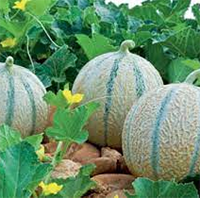
Cantaloupe melon genome reveals 3D chromatin features and structural relationship with the ancestral Cucurbitaceae karyotype.
Clement Pichot, Anis Djari, Joseph Tran, Marion Verdenaud, William Marande, Cecile Huneau, Veronique Gautier, David Latrasse, Sandrine Arribat, Vivien Sommard, Christelle Troadec, Charles Poncet, Mohammed Bendahmane, Judit Szecsi, Catherine Dogimont, Jerome Salse, Moussa Benhamed, Mohamed Zouine, Adnane Boualem, Abdelhafid Bendahmane.
Voir plus
Journal: IScience
https://doi.org/10.1016/j.isci.2021.1036
Abstract
Cucumis melo displays a large diversity of horticultural groups with Cantaloupe melon the most cultivated type. Using a combination of single-molecule sequencing, 10X Genomics link-reads, high-density optical and genetic maps and chromosome conformation capture (Hi-C) we assembled a chromosome scale C.melo var. cantalupensis Charentais mono genome. Integration of RNA-seq, MeDip-seq, ChIP-seq and Hi-C data revealed a widespread compartmentalization of the melon genome, segregating constitutive heterochromatin and euchromatin. Genome-wide comparative and evolutionary analysis between melon botanical groups identified Charentais mono genome increasingly more divergent from Harukei-3 (reticulatus), Payzawat (inodorus), and HS (ssp. agrestis) genomes. To assess the paleohistory of the Cucurbitaceae, we reconstructed the ancestral Cucurbitaceae karyotype and compared it to sequenced cucurbit genomes. In contrast to other species that experienced massive chromosome shuffling, melon has retained the ancestral genome structure. We provide comprehensive genomic resources and new insights in the diversity of melon horticultural groups and evolution of cucurbits.

